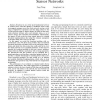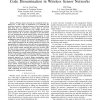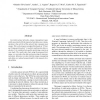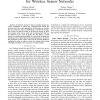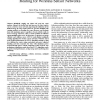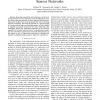INFOCOM
2009
IEEE
14 years 6 months ago
2009
IEEE
—Broadcast is one of the most fundamental services in wireless sensor networks (WSNs). It facilitates sensor nodes to propagate messages across the whole network, serving a wide ...
INFOCOM
2009
IEEE
14 years 6 months ago
2009
IEEE
Abstract—Wireless sensor networks are considered ideal candidates for a wide range of applications. It is desirable and sometimes necessary to reprogram sensor nodes through wire...
IEEESCC
2009
IEEE
14 years 6 months ago
2009
IEEE
Wireless sensor networks are application specific, data centric networks where different applications run on deployed network. Each application interprets the underlying sensor n...
RTSS
2009
IEEE
14 years 6 months ago
2009
IEEE
—Real-time detection is an important requirement of many mission-critical wireless sensor network applications such as battlefield monitoring and security surveillance. Due to t...
QSHINE
2009
IEEE
2009
IEEE
Joint Optimization of System Lifetime and Network Performance for Real-Time Wireless Sensor Networks
14 years 6 months ago
Maximizing the aggregate network utility and minimizing the network energy consumption are important but conflict goals in wireless sensor networks. Challenges arise due to the app...
ISCC
2009
IEEE
14 years 6 months ago
2009
IEEE
In wireless sensor networks, energy consumption is generally associated with the amount of sent data once communication is the activity of the network that consumes more energy. T...
ISCC
2009
IEEE
14 years 6 months ago
2009
IEEE
Abstract—In-network storage of data in wireless sensor networks contributes to reduce the communications inside the network and to favor data aggregation. In this paper, we consi...
ICC
2009
IEEE
14 years 6 months ago
2009
IEEE
—We consider multi-resolution storage, a technique for providing scalable adaptive data fidelity, necessary for many applications of large wireless sensor networks (WSNs). Altho...
ICC
2009
IEEE
14 years 6 months ago
2009
IEEE
—Multipath routing can reduce the need for route updates, balance the traffic load and increase the data transfer rate in a wireless sensor network, improving the utilization of ...
ICC
2009
IEEE
14 years 6 months ago
2009
IEEE
—Repairing connectivity and achieving a certain level of fault tolerance are two important research challenges in wireless sensor networks that have, in many papers in the litera...
